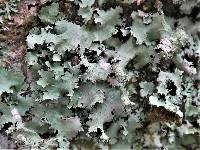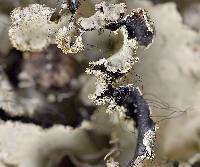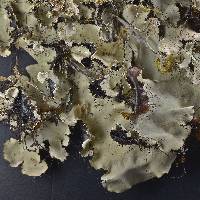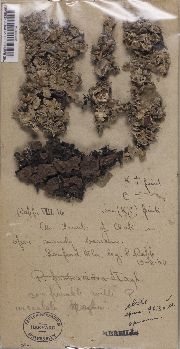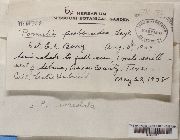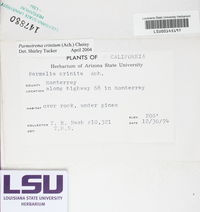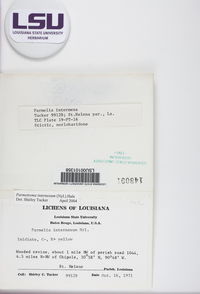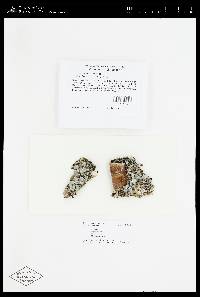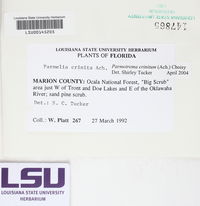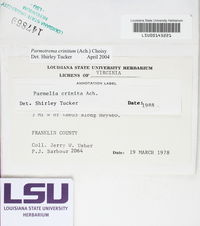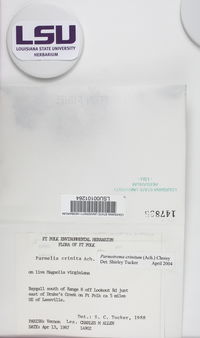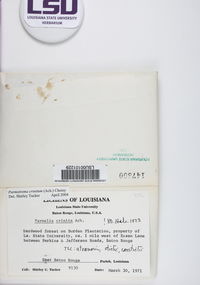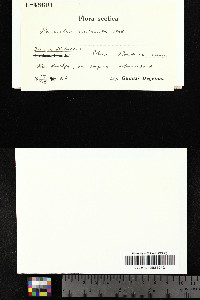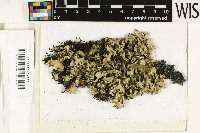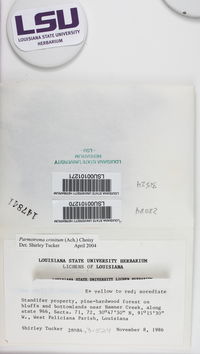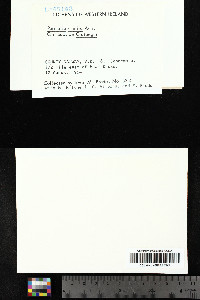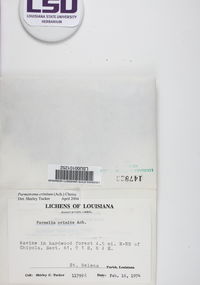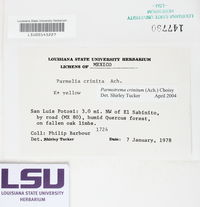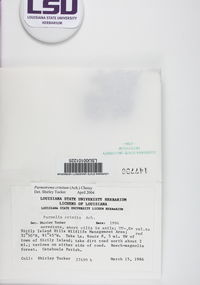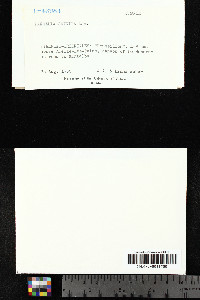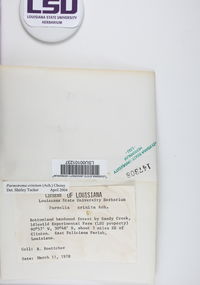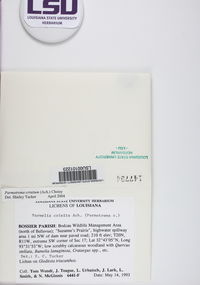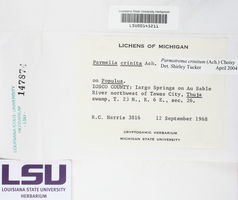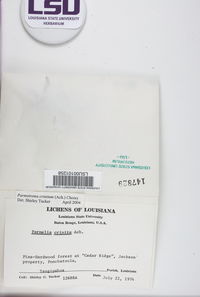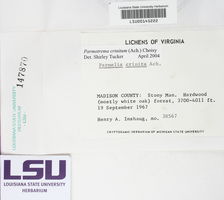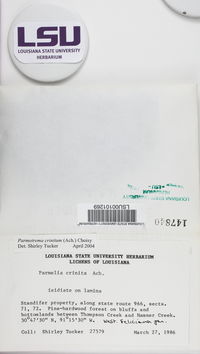
- Home
- Search
- Images
- Species Checklists
- US States: O-Z >
- US National Parks
- Central America
- South America
- US National Parks
- Southern Subpolar Region
|
|
|
|
Family: Parmeliaceae
Salted Ruffle Lichen
[Imbricaria crinita (Ach.) Arnold, moreImbricaria proboscidea (Taylor) Jatta, Parmelia chlorocarpa Müll. Arg., Parmelia crinita Ach., Parmelia crinita var. crinita Ach., Parmelia crinita var. inactiva H. Magn., Parmelia perforata subsp. crinita (Ach.) Tuck., Parmelia perlata f. dissectula Nyl., Parmelia proboscidea Taylor, Parmelia proboscidea f. bulbifera Hue, Parmelia proboscidea f. proboscidea Taylor, Parmelia proboscidea f. sorediifera (Müll.Arg.) Müll.Arg., Parmelia proboscidea var. corallina Müll.Arg., Parmelia proboscidea var. eciliata J.D. Zhao, Parmelia proboscidea var. ornatula Zahlbr., Parmelia proboscidea var. proboscidea Taylor, Parmelia proboscidea var. saxicola Sambo, Parmelia proboscidea var. sorediifera Müll.Arg., Parmotrema crinita (Ach.) M. Choisy] |
MycoBank no. 368891 Type: North America [Country unknown], [State unknown]: Muhlenberg, H. s.n., (H – holotype, fide Hale 1965). Description. Thallus corticolous, lignicolous, or saxicolous; upper surface whitish gray to ivory, shiny to ± dull, epruinose, emaculate, but occasionally in parts irregularly cracked; abundantly isidiate; isidia initially marginal but soon spreading across the thallus surface, cylindrical, simple to sparsely branched, occasionally closely clustered (caespitose), brown to blackened at their tip and frequently ciliate (cilia of caespitose isidia having a ‘tufted’ appearance); lobes broad, small to moderate-sized, 0.7–6(–8) mm wide, ± rotund, axils incised to ± rounded but not distinctly looped, margins abundantly ciliate; cilia very long and slender, 1–7(–8) mm long, black, mostly simple, very rarely branched; lower surface blackened throughout or with a narrow, deep brown, erhizinate, ~ 1–1.5 mm wide margin, blackening and becoming densely rhizinate towards the thallus center; rhizines long, slender, black, mostly simple, rarely sparsely branched; medulla white. Apothecia and pycnidia not observed among the Galapagos specimens. Chemistry. Cortex with atranorin [P+ yellow, K+ yellow, KC–, C–, UV–]; medulla with stictic, cryptostictic and constictic acid [P+ yellow, slowly orange; K+ yellow, KC–, C–, UV–]. Ecology and distribution. Cosmopolitan (e.g., Hale 1965; Elix 1994; Brodo et al. 2001; Chen et al. 2005; Divakar & Upreti 2005; Egan et al. 2016). First reported for Galapagos, Ecuador, by Weber (1986), subsequently by Elix & McCarthy (1998) and online (Bungartz et al. 2016). A moderately common species; found from the dry zone through the transition and humid zones into the high altitude dry zone; most abundant in the transition zone; typically on bark, rarely on wood or rock, often in somewhat sheltered and shaded habitats, but less frequently also at exposed sites; not known from introduced trees or shrubs, most common on Clerodendrum and Croton, often also on Bursera, Zanthoxylum or Hippomane. Notes. Morphologically very similar is P. neosubcrinitum, which has isidiate, abundantly ciliate lobes, typically also with ciliate isidia. The two species differ by their chemistry. The medulla of P. crinitum contains stictic acid and thus turns yellow in K. Parmotrema neosubcrinitum contains salazinic acid and its medulla in K quickly turns deep blood-red. Nash, T.H., Ryan, B.D., Gries, C., Bungartz, F., (eds.) 2002. Lichen Flora of the Greater Sonoran Desert Region. Vol 1. Thallus: foliose, adnate to loosely adnate, 3-15 cm in diam., lobate lobes: subirregular, elongate, slightly imbricate, plane, separate, 5-20 mm wide; apices: rotund, becoming crenate and dissected with age, sometimes ascending, ciliate; cilia: up to 3.0 mm long upper surface: gray with some blackened areas, smooth, dull to shiny, epruinose, emaculate, finely reticulately cracked with age isidia: simple to coralloid branched, sometimes disintegrating with age, often apically ciliate, common, laminal and marginal; soredia and pustulae: absent medulla: white with continuous algal layer lower surface: black with brown naked zone peripherally, centrally rhizinate, rhizines simple, black Apothecia: rare, substipitate, up to 8 mm in diam.; margin: sparsely isidiate; disc: brown, imperforate ascospores: ellipsoid, 21-35 x 11-18 µm Pycnidia: not seen Spot tests: upper cortex K+ yellow, C-, KC-, P-; medulla K+ yellow turning orange, C-, KC-, P+ orange Secondary metabolites: upper cortex with atranorin and chloroatranorin; medulla with stictic acid (major) and constictic acid (minor), menegazziaic acid (trace). Substrate and ecology: usually on hardwood trees in open habitats, rarely on rocks or soil World distribution: pantropical and pantemperate Sonoran distribution: SE Arizona southwards along the Sierra Madre Occidental in Chihuahua, Baja California and in the mountains of southern Baja California Sur. Assessed as Least Concern (LC), ver 3.1
Find out more about the IUCN Red List Categories and Criteria here. |
|
|
|




